Menu
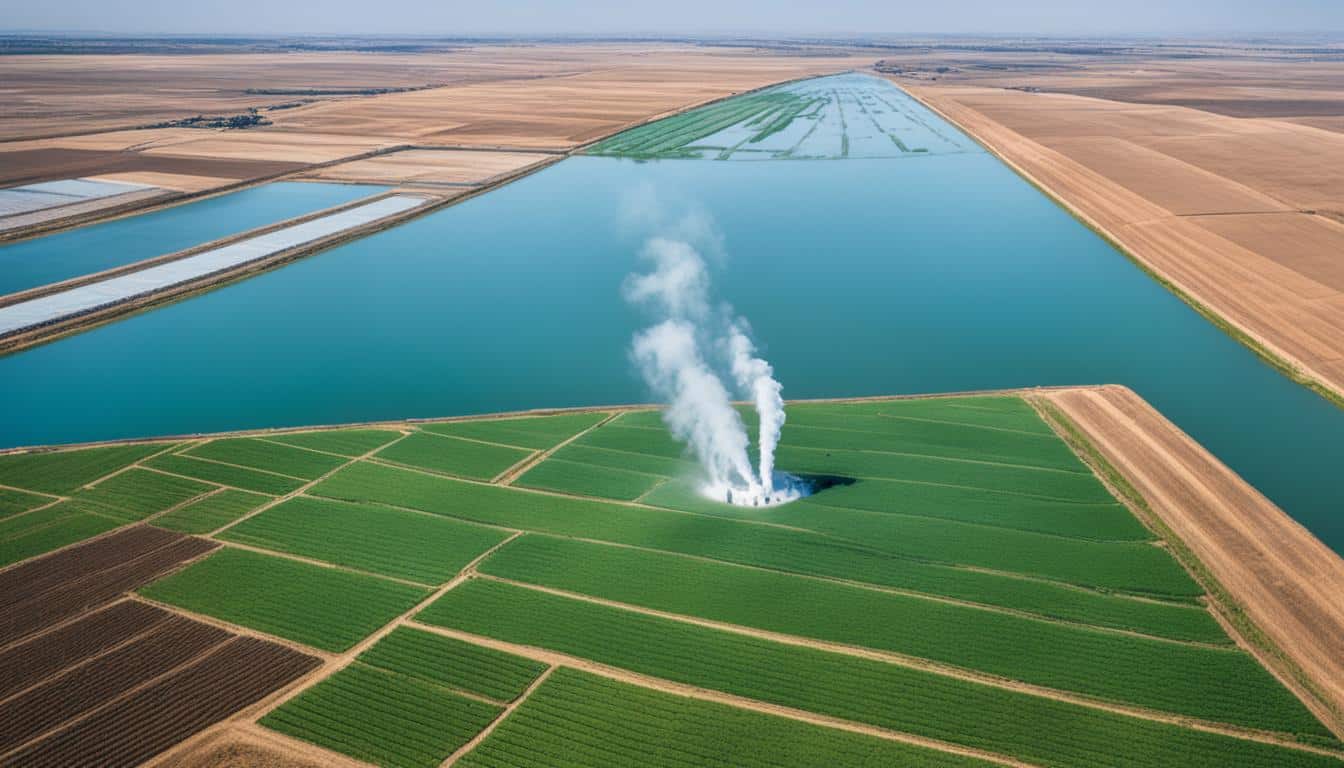
Did you know that food production makes up over a quarter of global greenhouse gas emissions? This shows how much farming affects our planet. About half of the world’s able land is used for farming. This also means a lot of water is used, with agriculture taking up 70% of the fresh water. It causes water pollution too, from nutrients washing into waterways.
Farming plays a big role in climate change, creating 25% of the world’s greenhouse gases. When we cut down forests for farming and have more farm animals than wild ones, it’s a problem. This reduces the variety of life on Earth and harms natural homes.
We need to rethink how we produce and eat food because of these big issues. Changing our ways can help fight climate change and save water and land. It’s important to farm in ways that don’t hurt our planet more.
Agriculture affects global warming by releasing greenhouse gases. It’s key to see agriculture as both part of the problem and able to offer solutions. This dual role is vital in fighting the climate crisis.
In 2021, the EPA says agriculture was responsible for 10.6% of U.S. greenhouse gas emissions. It let out 671.5 million metric tons of carbon-dioxide equivalent. The main gases were nitrous oxide, methane, and carbon dioxide.
Animals, such as livestock, emit a lot of methane. The growing of animal feed is also a major source of these gases.
The world’s yearly average temperature has gone up by about 1.8°F (1.0°C) over the last 115 years. Agriculture contributes about 26% of these global emissions. These figures mean we need to act fast to protect our crops and food supply.
By 2036, U.S. corn harvests might rise by 3.1%, but soybean yields could drop by 3.0%. These stats show how crucial it is to adapt. We must find ways to farm that can cope with these changes.
To lower its environmental harm, agriculture needs to adopt green farming techniques. These include mixed farming systems, using less chemicals, and growing special plants to cover the soil. Such methods boost the soil’s ability to cope with weather changes and help tackle flooding and droughts.
Also, we must invest in communities to help them deal with climate effects. This ensures everyone benefits from efforts to adapt.
“The urgent need to bring net emissions of heat-trapping gases down to zero is clear, and addressing the root cause of climate change within the agricultural sector is essential for a sustainable future.”
To fight climate change, agriculture must change how it operates. We need to farm in ways that do less harm to our planet. Acting together, we can make agriculture a force for good in our fight against climate change.
Agriculture uses about 70% of the world’s freshwater, mainly for irrigation. This need for water will grow by 2050. This raises worries about how these practices impact the environment.
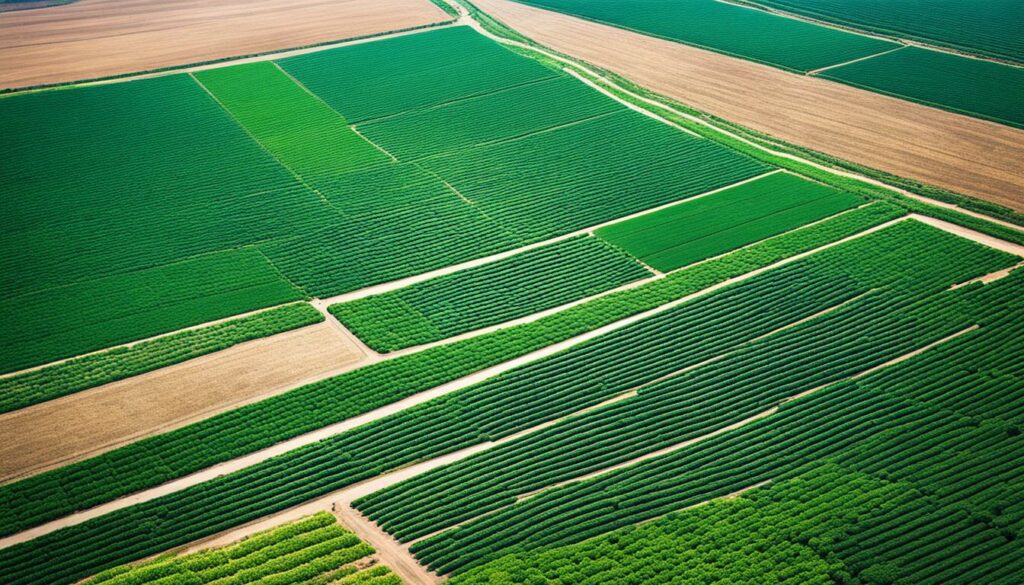
Farming uses too much water, harming the land and changing weather patterns. In the U.S., people eat more meat each year. This has led to more greenhouse gases and greater water use in farming.
Farm waste, like pesticides and nutrients, get into water. In 2018, U.S. farmers put tons of nitrogen on crops. This can cause too much algae and harm the water in places like the Chesapeake Bay.
Livestock also produce lots of manure, which can pollute the water.
It’s vital to use water in farming more wisely to help the environment. Farming in ways that use less water and cause less harm is key. This includes using less fertilizer and farming more precisely. These changes can lower the need for new water, protect nature, and help farming stay sustainable.
Agriculture plays a big role in deforestation, responsible for about 80% of it worldwide. The need for more farmland leads to forests being turned into fields for crops and pastures for animals. This change causes many animals to lose their homes.
Every year, about 10 million hectares of forest are cleared by people for farming. This happens mostly in the tropics, with Brazil and Indonesia losing a lot of trees. Nearly 88% of deforestation globally is because we need more space for growing food and raising animals.
| Country | Percentage of Global Deforestation |
|---|---|
| Brazil | 33% |
| Indonesia | 19% |
The impact of deforestation on wildlife is huge. Over half of the world’s land we can live on is used for farming, which has hurt many animals and plants. We’re losing about 135 species every day because we are cutting down their homes. In the Amazon, more than 10,000 species could disappear because of deforestation.
“Agricultural activities are a principal cause of habitat destruction, leading to alarming rates of biodiversity loss,” states a recent study on global environmental impact.
People are working hard to fight deforestation and to grow new forests. Reforestation helps by planting new trees and bringing back natural habitats. There are new ideas, like rewilding, that can also help reduce the amount of harmful carbon dioxide in the air. If we rewild 30% of the world’s land, we could cut carbon emissions in half. This shows just how important efforts to plant trees again are for the future.
Soil degradation from farming is a big worry. It’s caused by too much tillage, not managing land well, and using strong chemicals. These practices lead to soil erosion and fertility loss. In the Midwest, half of the topsoil has eroded in 50 years because of human activity. Iowa, for example, has lost about 6.8 inches of its topsoil since 1850.
Erosion costs the US about $37.6 billion in lost productivity every year. 60% of that soil flows into waterways, harming the environment further. In 2019, heavy spring rains in the Midwest caused a lot of soil erosion. Dry parts of North America suffer from wind erosion too, losing lots of soil each year.
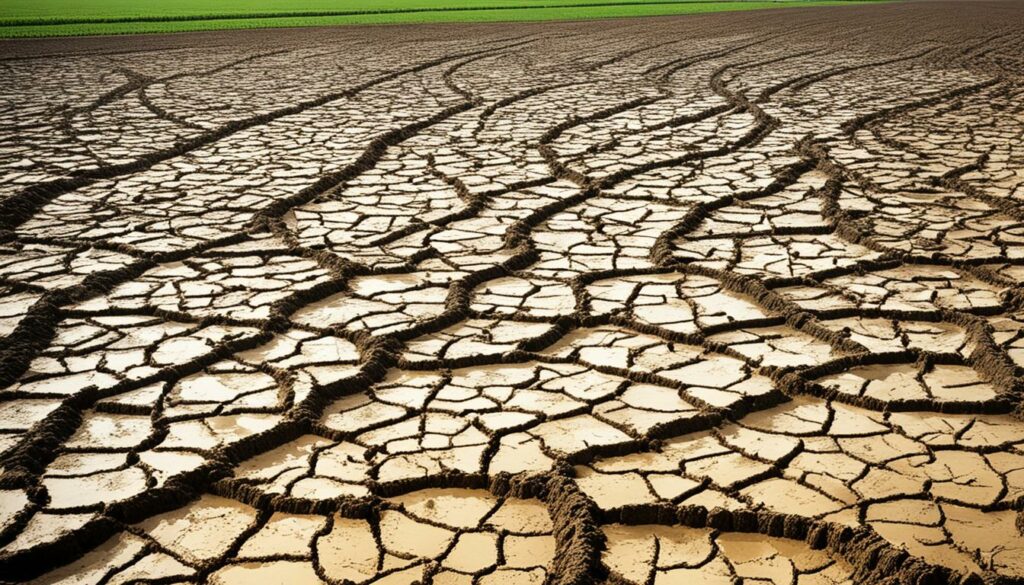
Soil degradation happens for many reasons, including the land’s condition, how severe the stress is, the reaction to stress, and feedback from those reactions. It can be biological, chemical, ecological, or physical. Bad farming practices like planting the same crop over and over and using too many chemicals make it worse.
| Region | Topsoil Loss (inches) | Annual Productivity Loss (USD) | Primary Cause |
|---|---|---|---|
| Iowa (Midwest) | 6.8 | $37.6 billion | Human Activity and Erosion |
| Tropical Arable Lands | 183-248 tons/ha/year | Not specified | Natural and Human Factors |
Soil degradation has many bad effects. It causes soil to be too salty, too acidic, less organic, compacted, and less good for crops. This means less nutrients for plants, which hurts crop yields. Soil pollution from chemicals and waste is also a big risk to people and the environment.
To tackle soil degradation, we need to farm in a way that doesn’t harm the land. Choosing methods like conservation farming and planting more trees helps. These approaches focus on saving and fixing the soil. This way, we can keep the land productive and support a healthy, balanced environment.
Livestock farming has a big impact on the environment. It mainly affects the planet through greenhouse gases and land damage. Knowing about these issues helps us move towards farming that’s better for the Earth.
Livestock farms create a lot of methane. This gas is a big factor in climate change. It’s about 25 times more powerful than carbon dioxide. Each year, around 70 billion animals are raised worldwide. This makes the methane emissions from them a major part of the 7516 million tons of CO2 the industry releases annually, because of their large numbers.
Livestock can cause a lot of damage by overgrazing. This leads to problems like soil getting hard, eroding, and losing nutrients. These farms take up a lot of land, affecting the Earth greatly. Creating pastures by cutting down forests has been a big issue too, with an area twice the size of Portugal being lost between 1990-2000.
| Methane Emissions from Livestock | Global Warming Potential |
|---|---|
| Livestock contribute 35-40% | 25 times more potent than CO2 |
| 7516 million tons of CO2 annually | 51% of total greenhouse gases |
To help the environment, people should eat less from animal sources. This simple change in our diet makes a big difference. Using better ways to farm and manage land also helps. Going vegan not only reduces your impact but saves a lot of water, crops, and forested areas too. These steps are important for meeting our food needs without harming the planet as much.
The use of chemical fertilisers and pesticides affects our environment and health. These substances make soil and water worse, hurting the Earth in the long run.
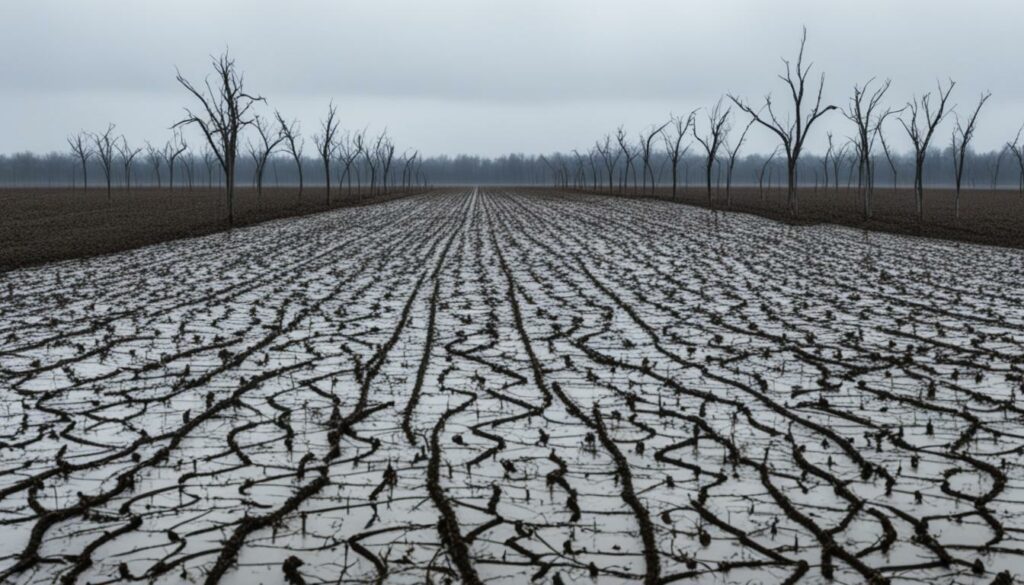
Chemical fertilisers and pesticides badly affect soil and water. Since 1961, more meat eat world’s food grows, needing more of these chemicals. This has made the soil and water full of harmful nitrogen. Nature suffers with algal blooms and dead zones. The Gulf of Mexico’s dead zone gets worse due to these fertilisers.
There’s a big health risk from these chemicals too. Pesticides in our food can cause long-term sickness. Each year, about a million people get sick from pesticides worldwide. In the U.S., too much pesticide in rivers is dangerous. It can lead to nearly 18,000 deaths. Livestock waste combined with these chemicals is also deadly.
We need to find better ways to farm. Organic methods and precision farming can help. These methods don’t use harmful chemicals excessively. They keep the soil and water clean. Agroecology is another option. It focuses on using nature’s diversity to grow food safely.
Finding better ways to farm makes our environment and our health better. It’s important for everyone to work together. Governments and farmers must choose practices that are safer for us and for nature.
By 2050, there will be nearly eight billion people on the Earth. To feed them, we’ll need to produce more food, around 70% extra. This is quite a challenge. Agriculture has big effects on the environment. It can harm our planet’s natural balance.
In the late 20th century, we saw a shift towards sustainable farming. This change started after important reports such as “Our Common Future” in the 1980s. The aim was to fight the harmful effects of traditional farming. Sustainable farming looks to grow food without hurting the environment. It also wants to be good for the economy. And it should treat everyone fairly.Sustainable farming uses methods that are good for the Earth. It uses local resources, less water, and natural fertilisers. This not only helps the environment. It also boosts local economies. It gives small farmers more ways to make money. This leads to us having reliable food supplies. So, everyone can get food that doesn’t cost too much.Consequently, communities gain consistent access to affordable food options.This type of farming also looks at different ways of eating. Vegan diets and growing food in cities are two good examples. They offer food that is better and often cheaper. Places like Plug and Play’s Agtech innovation help by bringing new ideas and money to support these ways.
After the Second World War, farming changed a lot. New technologies and more chemical use made food and cloth more than ever before. But, this focus on making things cheap had a big environmental price. It made people see the importance of farming in a way that protects nature.
According to the USDA’s National Institute of Food and Agriculture, sustainable agriculture is integral to protecting the environment, maintaining soil fertility, and expanding our natural resource base.
Important qualities like being able to stay strong in hard times, being able to change, and having lots of different parts are key. They make sure farming ways last and work well.
Working together is important for sustainable farming. It needs researchers, farmers, workers, sellers, buyers, leaders, and others. Their teamwork is vital for making farming better for the future.
Since the 1980s, sustainable farming’s ideas have grown and changed. They keep up with what’s happening now. This way of farming is not just one thing, but a range of ideas. For example, farming that mixes different ways to control pests helps show we need many approaches.
Farms that do both livestock and crops need fewer man-made fertilisers. This is better for the soil and makes farming last longer.
Agroecology aligns farming with nature’s principles, linking agriculture with the environment. It focuses on diversity, synergy, efficiency, resilience, and closed nutrient loops.
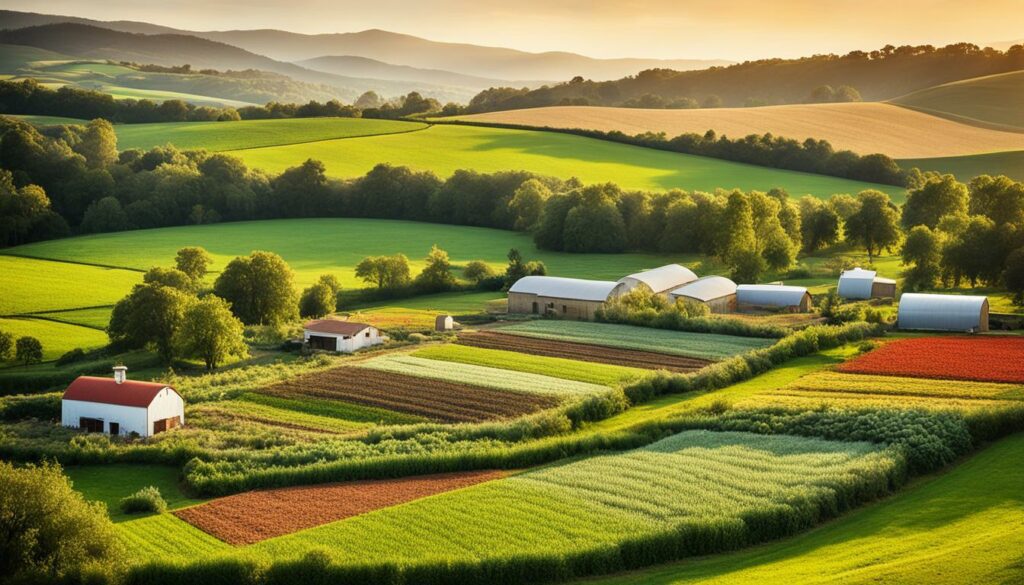
Agroecology integrates farming with the natural order, valuing farmers’ and local peoples’ wisdom. It urges nutrient recycling, like through composting, to enrich soils. It supports planting native seeds and growing various crops for a healthier agriculture and to maintain biodiversity.
Agroecology significantly boosts biodiversity, making agricultural lands richer in life and preserving species. It avoids heavy chemical use, safeguarding soil and water. This method leads to thriving ecosystems and better food quality by encouraging biological actions and discouraging pesticides.
Case studies from around the world show how agroecology can succeed. In Kenya, planting insect-repelling crops alongside corn raised yields and improved soil. In Japan, using ducks and fish in rice fields eliminated pesticides and added proteins. Such stories prove the power of agroecology in sustainable farming.
Worldpackers and similar platforms let people get involved in agroecology projects globally, for environmental care and gaining skills. Agroecology’s strength is in empowering farmers, supporting family agriculture, and keeping the land’s cultural traditions alive.
Technological innovations in farming are changing the game. They include precision farming, renewable energy, and advanced crop engineering. This technology boosts farming’s efficiency and cuts its environmental impact.
Precision farming fine-tunes crop management with high-tech tools. Sensors check soil’s pH, aerial images pinpoint problems, and track livestock. GPS gathers info on machines, and drones apply pesticides where needed. This approach hikes yield and trims waste, showcasing tech’s benefits in farming.
Moving to renewable energy is key for sustainable farming. Solar, wind, and bioenergy cut the use of fossil fuels. They reduce harmful gas emissions and make farming more robust. These energy sources help farmers save money and help the environment.
Crop engineering is making big changes. It uses biotech and CRISPR to create crops with great traits. These crops can produce more, resist disease, and handle tough conditions better. This tech improves food security and cuts farming’s impact on nature.
| Technology | Benefits |
|---|---|
| CRISPR | Increases crop yield and disease resistance |
| Biotechnology | Develops transgenic animals with higher growth rates and lean muscle mass |
| Genetic Engineering | Enhances traits specific to aesthetics and tolerance |
To sum up, these farming techs make better use of resources. They lead us towards more sustainable and productive farming. This helps tackle big issues like the climate and food needs globally.
Urban areas are growing fast, making sustainable farming more important. Urban and vertical farming are new ways to farm, using hydroponics and aquaponics. These methods save space and resources and care for the environment.
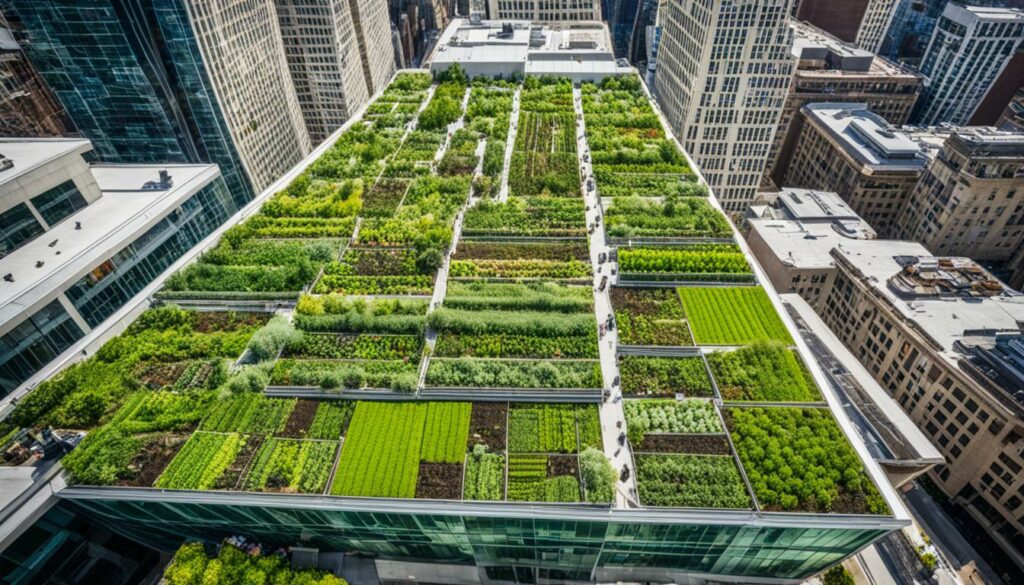
Hydroponics and aquaponics have many advantages in city farming. Hydroponics grows plants in water with nutrients, and aquaponics adds fish to the equation. They don’t need soil, using less water than traditional farming.
For example, growing 1 kg of tomatoes in a vertical farm uses only 2-4 litres of water. But in the field, you need 60-200 litres for the same amount.
City farming helps the environment in many ways, offering a new path for farming. Vertical farming uses 95-99% less water, a big win for water conservation.
Also, farms in towns mean food travels shorter distances. This cuts down on food waste from transport.
These farms need hardly any pesticides, making a safer, cleaner world. They don’t use as much machinery, which cuts carbon emissions and protects the land.
Urban farming has challenges too. It’s expensive to set up and run at first. There are also issues with using energy, complex technology, and sharing farming knowledge.
Rules and where you can build farms make things harder. But, city farming can grow big, involve the community, and make jobs. It uses city spaces efficiently and turns empty buildings into farms, making cities more sustainable and their food healthier and fresher.
To summarise:
| Comparison | Traditional Agriculture | Urban & Vertical Farming |
|---|---|---|
| Water Consumption | High (70-80% of global freshwater withdrawals) | Low (Uses up to 95% less water) |
| Land Use | Extensive | Minimal (Vertical farms reduce land usage) |
| Pesticide Usage | High | Reduced or Eliminated |
| Carbon Emissions | High (due to long transportation routes) | Low (Local production reduces emissions) |
Urban and vertical farming are changing how we think about farming. They offer modern, sustainable solutions with benefits for the planet and economy.
Monocultures and factory farming are key parts of modern farming. They aim for big harvests and efficiency. But, these ways hurt the earth a lot.
Monocultures lead to poor soil, infertility, and erosion. They use lots of chemicals, which gets into our water. This is bad for the plants and animals that live there. Factory farming is bad too. It causes cutting down trees, a lot of methane gas, and dirty air and water.
Growing different crops helps our farms and the earth. It makes the soil better, stops too many pests, and can handle bad weather. Sustainable farming means using fewer chemicals. It helps plants, animals, and the environment. Switching from monocultures can make our farms and nature healthy again.
We need strong rules to make farming better for the planet. These rules should encourage varied crops and good farming ways. They should also limit chemical use. Doing this helps keep farming going and protect our nature.
| Environmental Issues | Traditional Practices | Sustainable Practices |
|---|---|---|
| Soil Health | Depletion, erosion, and infertility | Enhanced through crop rotation and organic methods |
| Biodiversity | Loss due to monocultures | Preserved by diverse cropping |
| Pollution | Water pollution from chemical runoff | Reduced through minimal chemical usage |
| Greenhouse Gas Emissions | High due to factory farming | Lowered through sustainable farming practices |
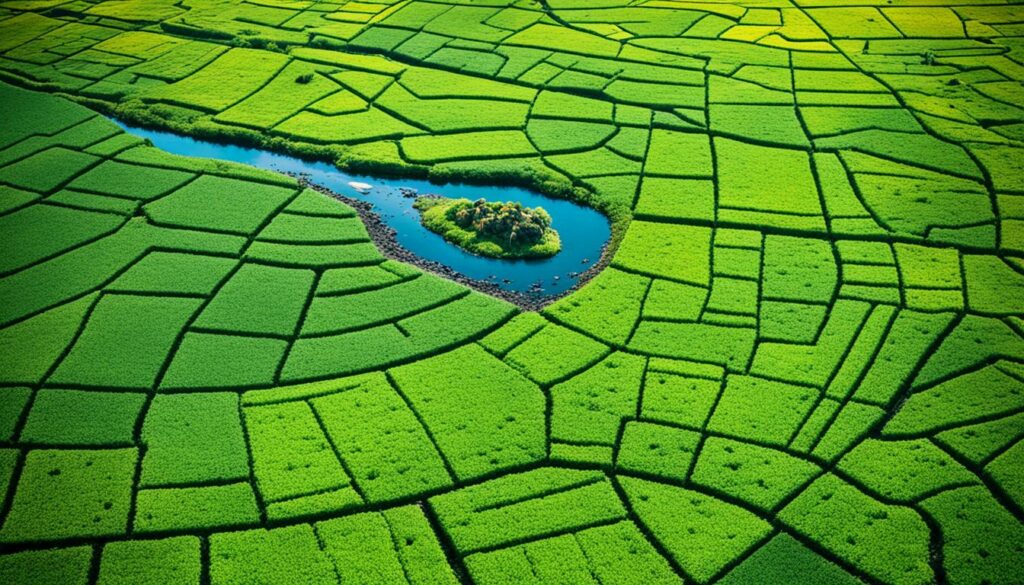
The environmental impact of farming is huge—26% of greenhouses gas emissions come from it. I strongly believe in the need for solid policies and good governance. It is key to put farming’s environmental effects and new green methods high on the government’s list.
Creating strong policies for farming’s environmental effects is key. Farming uses a lot of our livable land and takes up 70% of the world’s fresh water. We need laws that promote earth-friendly farming and punish harm to our planet.
Consumers can change agriculture by choosing sustainably grown foods. This helps lower the harm farming does to our world. Also, eating more plants and less meat reduces the space and gases farming uses up. It’s important to buy from local farmers focused on being green.
The future of farming is all about new ideas. Things like smart farming and using more clean energy show a lot of promise. Smart farming uses less and does more, and clean energy reduces our need for polluting sources. Innovation is key to greening up our food production.
| Key Environmental Impact | Current Statistics | Future Projections |
|---|---|---|
| Global Greenhouse Gas Emissions | 26% from food systems | Reduction through sustainable practices |
| Freshwater Withdrawals | 70% used for agriculture | Increase by over 15% by 2050 |
| Nutrient Pollution (Eutrophication) | 78% caused by agriculture | Reduction via innovative farming techniques |
We need a mix of new policies, changed shopping habits, and greener farming ways. Together, these steps can lead to a farming future that’s better for the environment.
Our choices every day have a big impact on the environment, especially in farming. By picking eco-friendly food, supporting local farmers, and reducing food waste, we help the planet.
Eating food that’s made with the planet in mind is key. For instance, by using different crops and more diverse farms, the need for chemical pesticides drops by 50%. These innovative farming methods also help grow more food, protecting the environment and ensuring we have enough to eat. Remember to choose organic items whenever you can to cut down on harmful chemicals and gas emissions.
Back local farmers and you help save resources and boost nearby economies. Think about it, food in the U.S. travels 1,500 miles to get to us, adding loads to the gases heating up the planet. Buying local means shorter trips, saving on resources and cutting emissions. Plus, sustainable farms earn more, around 15%, from things like fruits and nuts, thanks to smart eco-friendly farming.
| Practice | Environmental Impact | Economic Impact |
|---|---|---|
| Rotating Crops | -50% Chemical Pesticides | Increased Yields |
| Agroforestry | Improved Biodiversity | +15% Income |
| Local Distribution | Reduced GHG Emissions | Economic Benefits |
Less food waste means a better food system and less harm to our world. Planning meals, storing food right, and composting your scraps trims the food thrown away. This helps cut methane, a big climate change gas, from rotting leftovers. Everyone’s effort in tackling food waste is a game changer for sustainable farming.
Farming’s effect on the environment is serious. It uses 70% of the world’s fresh water and half its livable land. Livestock takes up 94% of wild animal biomass. Food making also causes 26% of all greenhouse gases. By 2050, we will need 15% more water for farming to feed everyone. This will add to the problems we face today.
To reduce this, we must farm in ways that protect our planet. Using new farming methods and technology can help a lot. So can farming in cities. These steps can lower the harm to our air, water, and land. They also help fight climate change and protect nature.
Each of us can make a big difference by what we buy and eat. Picking sustainable foods and avoiding waste helps. Backing local farmers is another good choice. Together, we can help the planet. We need to support ways of farming that don’t hurt nature. This is key for a future where we can all thrive, now and later.
Farming uses a lot of water and is a big cause of greenhouse gas emissions. It also leads to cutting down trees, which affects the soil and makes plants and animals lose their homes. This means that farming has a big impact on the environment all around the world.
Farming mainly makes methane gas from animals and nitrous oxide from fertilisers. When we dig up the soil to plant crops, it also releases carbon dioxide. These gases are bad for the air we breathe and the planet’s health.
Farming can make the water dirty. This happens when the rain washes chemicals from fields into rivers and lakes. These chemicals can be harmful, causing plants like algae to grow too much and harm the water and animals that live in it.
Monoculture is when we grow just one crop over a wide area. It’s not good for the environment because it can make the soil lose its nutrients, and many pests like to eat the same crop. To control these pests, we have to use a lot of chemicals. This is not good for the soil and water.
Sustainable farming looks after the land by using methods that do not harm the environment. These ways include planting different crops in rotation, farming without chemicals, and using less water. This kind of farming helps the soil stay healthy, keeps the water clean, and supports many different plants and animals.
Cutting down forests for farming means many animals and plants lose their homes. It also makes the earth warmer because there are fewer trees to take in carbon dioxide. This harms the planet and the things that live on it.
Agroecology is farming that works with nature. It grows many different crops and trees. This helps different animals and plants to live and grow together. It keeps the farm land healthy and helps in fighting off bad changes in the environment.
What we choose to eat and buy makes a big difference. By picking food that’s good for the planet and supporting local farmers, we can help the kind of farming that is good for the environment. Making smart food choices means farmers will also start doing things in a better way.
Precision farming uses high-tech tools to farm better. By using GPS, sensors, and computers, farmers can use less water and reduce waste. This means they can grow more food without hurting the planet as much.
Farming in cities and in tall buildings uses less space and water. Techniques like hydroponics and aquaponics let us grow food with less waste and closer to where people live. This saves the environment and the places where food comes from.
Making farming sustainable can be hard because it costs a lot at first and some ways are new. It also needs help from the government, learning, and more people knowing about it. Overcoming these problems is key to having farming that’s good for the earth.
Chemicals used in farming can make the soil and water dirty. They harm the plants and animals that live there and can make the water unsafe for us too. Using less of these chemicals and finding other ways to grow food is better for everyone and everything.
Planting trees again and fixing damaged land helps nature and slows down climate change. It also makes new homes for many animals and birds. Reforestation is an important step in making our food and land work well together.
Soil is very important for growing food and for keeping the water clean. Taking care of the soil by not digging it too much and adding natural things to it keeps the land healthy. Healthy land means we can keep on growing food for a long time.
There are ways to raise animals that are better for the planet. This includes eating more plants, letting animals graze freely, and moving them to different fields. These ways make less pollution and don’t harm the land as much.
Choosing what we eat and buy wisely helps the farmers and the earth. By picking food that is good for the land and not wasting what we buy, we all help make farming better. Everyone’s choices add up to make a big difference for our environment.